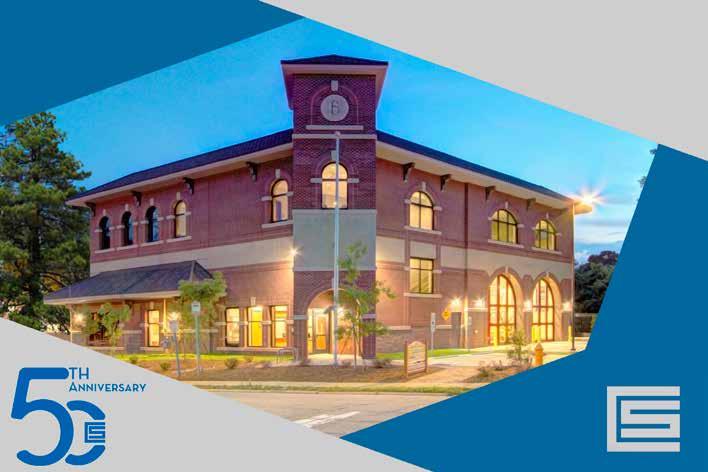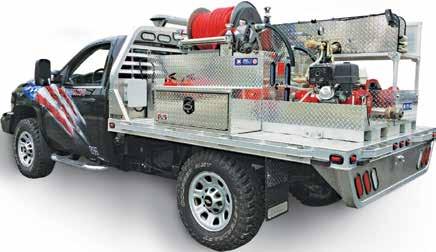
10 minute read
Building Resiliency in the Fire/EMS Service
Scott A Robinson
When I joined the fire service in 1995,
Advertisement
I never imagined I would spend so much time advocating about resiliency in the fire service. In 2003, while assigned to the back step of
Engine 4 for the City of Cranston,
Rhode Island, we responded as a mutual aid company to the Station
Night Club fire in West Warwick,
Rhode Island where we assisted the
Town of West Warwick in fighting the fire from around 11:30 p.m. until about 2:00-3:00 a.m. and then assisted with body recovery until after 7:00 a.m.. Afterwards, we were placed back in service and returned to our city for our reliefs. The tragedy of that fire yielded 100 fire fatalities and about 300 injuries. Little did I know the experience would affect me for years to come as well.
Today, the word “resiliency” holds a much different definition for me than if I had been asked for the definition in 2003. In 2003, I would probably have said simply, “Resiliency means to withstand adversity.” Knowing what I know now though, I can safely say that that simple definition is a bit inadequate. The American
Psychological Association (APA) defines resiliency as the process of adapting well in the face of adversity, trauma, tragedy, threats, or significant sources of stress — such as familial and/or relationship problems, serious health problems, or workplace and financial stressors. Today, I would define resiliency as a process. Resiliency is one’s ability to face overwhelming stress, find a way to overcome that stress, and then thrive after having had the experience. Seventy billion of that cost was spent on depression treatment alone. (APA, Lea Winerman March 2017, Vol 48, No. 3). The numbers have surely increased since then.
Stress reactions are normal physiological responses and are our body’s way of maintaining homeostasis in the presence of a “threat”. When we respond to a stressor, our bodies trigger a cascade of stress hormones that produce well-orchestrated physiological changes. Our heart pounds, our breathing quickens, our muscles tense, and beads of sweat appear. Sometimes, we even experience nausea and vomit, as a reaction to the neurochemicals that are released into our system.
These physiological responses happen to avert stress or protect our lives from the stress at hand; however, when stressors are always present and one is constantly exposed to stressful situations, like when the bell or tones go off for the next run, that fight-orflight reaction stays turned on.
The long-term activation of the stress response system and the overexposure to cortisol and other stress hormones that follow can disrupt almost all the body’s processes. This long-term activation puts individuals at increased risk for many health problems, including: • Heart disease, heart attack, high blood pressure, and stroke (the number one killer of firefighters) • Anxiety • Depression • Digestive problems • Headaches • Muscle tension and pain • Sleep problems • Weight gain • Memory and concentration impairment
Today, the word “resiliency” holds a much different definition for me than if I had been asked for the definition in 2003. In 2003, I would probably have said simply, “Resiliency means to withstand adversity.” Knowing what I know now though, I can safely say that that simple definition is a bit inadequate.
In order to understand why resiliency is important, first, we have to understand what stress is and how it affects us. Stress is a non-specific physiological response that occurs in our bodies from either a real or perceived threat, challenge, or change. Imagine, 75% to 90% of all visits to physicians are stress-related (The Effects of Stress on Your Body, 2021) and in the U.S. alone we spent $187.8 billion on mental health conditions and substance use disorders in 2013.
Stewart-Cooper-Newell Architects
fire stations. ems. training facilities.




www.fire-station.com 704.865.6311 Raleigh, NC Fire Station No. 6




(https://www.mayoclinic.org/ healthy-lifestyle/stress-management/ in-depth/stress/art-20046037)
The mantra I heard while “growing up” in the fire service was: If it’s not broke, don’t fix it. Obviously, this advice was not related to unseen behavioral health issues but was formulated on the premise that if you were managing through something, you would be fine. That is not the case, however. Eventually, things that cause stress may, and often do, become unmanageable and when an individual lacks the skills necessary to handle that overwhelming stress, that person suffers. Of course, it’s not only the individual that needs coping skills but our organizations do also as well. When our organizations do not embrace developing and practicing skills that make our workforce resilient, we suffer. This is why, not only is individual resiliency important, but also building organizational resiliency is paramount.
Unfortunately, there are not many studies on resiliency and coping strategies within the first responder community, but there are several studies that have been done within the nursing and physician workforce from which the first responder community can learn. For instance, inside the health care field, several common characteristics or traits contributing to resiliency have been identified within those workforces. A study that included 1554 nurses from around the Pacific rim found that regardless of culture, there were four characteristics most utilized for the purpose of healthy coping skills that contributed to





resiliency: self-control, seeking social support, problem-solving and positive reappraisal (Lambert et al, 2004).
In another study of nurses and their coping strategies, (Chang et al, 2007) researchers discovered several characteristics that seemed to be contributory factors found in less resilient nurses, particularly in those who practiced escape-avoidance, which is a maladaptive form of coping in which a person changes his/her behavior to avoid thinking about or doing difficult things. Another maladaptive coping skill found was distancing. This resulted when nurses distance themselves from the stress and treat work-related stressors as non-personal. Finally, the study also identified nurses who had a degree of self-control, which ultimately caused them to isolate their true feelings from everyone. Each of these factors, escape-avoidance, distancing, and self-control, were predictors of lessresilient staff.
Based on these studies it is evident that there are several ways to identify a resilient person. Resilient people confront their fears, rather than isolate themselves from them. They maintain an optimistic outlook and have a supportive social network including great mentors, or role models. They practice emotional literacy, or the ability to listen to others and empathize with their emotions and manage those emotional reactions. This allows them to recognize the impact of their emotional state on their problemsolving. (Howe 2008). Ultimately emotional literacy teaches a person to express emotions productively. Additionally, they have great success in facing overwhelming stress in their lives because they not only accept what cannot be changed but recognize they can control how they respond to what cannot be changed.
Our first responder professionals are some of the most resilient people out there and I have worked with many of them during my 28 years in the fire service. Typically, those individuals have great social networks and family support. They have an optimistic view of the job rather than a pessimistic view. They recognize what they cannot control and what they can control. When I think back over those 28 years in the fire service, the happiest assignments I had occurred when I was working in places with people like these individuals.
Resiliency is important. It protects us against heart disease, potentially increases life expectancy by ten years, inoculates us against the daily grind and traumatic life-altering events, improves our job satisfaction and productivity, boosts the immune system, and lowers the risk of alcohol and drug dependency; however, resilience is not an innate, fixed characteristic. It can be developed through targeted interventions. (McAllister and McKinnon 2008)
To be resilient individuals must focus on several factors: 1. Find satisfaction attained through their work 2. Develop positive attitudes and/or a sense of faith


















3. Recognize that they make a difference in the lives of those they serve 4. Utilize strategies such as peer support 5. Validating and self-reflection of emotional literacy 6. Accept support from colleagues, mentors, and crews 7. Seek education on mindfulness 8. Maintain a work-life balance.
Over 7000+ units in service worldwide! Designed Right. Built Right. Priced Right.
The Widest Range of Off-Road UTV and Brush Truck Skid Units for Public Safety

Resiliency does not end with the individual. We are only as strong as the organizations that support us. We need to foster resiliency in our departments, starting in our recruit schools by encouraging curriculums that nurture reflective learning, emotional literacy, empathy, and self-awareness education. Recruits also need to develop narrative writing skills as students. Departments need to provide supportive supervision in the workplace by educating our supervisors to provide safe environments in which first responders can reflect on their reactions to events and they can disclose and discuss their emotional reactions. Fire Departments and Emergency Medical Services (EMS) agencies need to develop peer and mentoring programs to help develop supportive relationships.
Without the adequate resources and support through the development of individual and organizational resiliency in our fire departments or EMS agencies, even highly resilient responders will be unable to survive, let alone thrive.
Available in High-Pressure and Ultra-High-Pressure. 125-160-200 Gallon, Standard Capacities. 225-250-275-300 Gallon, Custom Capacities. Darley, Davey and CAT Pumps.
PROUDLY MADE IN THE USA
NEW Ultra High Pressure Line Up
12 Models
to choose from

FDHP Basic Truck Skids FCUHP Deluxe Truck Skids
www.brushtruckskids.com
FIRELITE ®and MEDLITE ®
15 Quality designs to fit most make & model UTV 4x4, 6x6 and crew vehicles.
FDH-203 FST-204
Scott A. Robinson is a Lieutenant with the Cranston, RI Fire Dept and has been a firefighter for 28 years. He is one of the IAFF Union’s Behavioral Health Specialists in the Department of Occupational Health and Medicine. Scott is former President of IAFF, Local 1363, and former Vice President of the Rhode Island State Association of Fire Fighters. He established the Rhode Island State Association of Fire Fighters’ Members Assistance Program (MAP) which is available to all union firefighters, active and retired, throughout RI, as well as their families. Scott is a Peer Support Master Instructor for the International Association of Fire Fighters, where he teaches peer support to IAFF locals in the U.S. and Canada and has been deployed on behalf of the IAFF to disaster areas across the country including Hurricane Harvey and the Champagne Tower collapse in Miami.
10 Models
to choose from
ALL UNITS SHIP FULLY ASSEMBLED
MTB-101
5 Models
to choose from

MTD-103

NOTE: Stretcher, long board and stokes baskets are not included.





